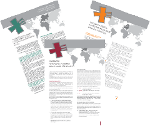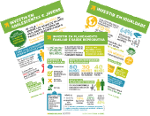Tendências em mortalidade materna 2000 a 2020
 Uma mulher morre a cada dois minutos por causas evitáveis associadas à gravidez ou ao parto.
Uma mulher morre a cada dois minutos por causas evitáveis associadas à gravidez ou ao parto.
“Precisamos aumentar os esforços com prevenção e cuidados adequados para que a gravidez e o parto sejam momentos de felicidade e realização de expectativas e direitos para as mulheres e famílias”, refere Alice Frade, Diretora Executiva da Associação P&D Factor em comentário ao relatório apresentado hoje pelas Nações Unidas.
“Com os avanços tecnológicos em matéria de diagnósticos, tratamentos e medicamentos essenciais, com mais conhecimentos e profissionais com formação adequada, os dados deste relatório convocam-nos para a ação imediata, consistente e coerente para que nenhuma jovem ou mulher seja esquecida e deixada para trás”.
Os dados do relatório “Trends in maternal mortality 2000 to 2020” mostram que não estamos a fazer o que precisa ser feito para evitar o sofrimento, as morbilidades e as mortalidades associadas à gravidez, garantir maternidades e paternidades desejadas e a igualdade no acesso e acessibilidade aos cuidados de saúde sexual e reprodutiva e maternidade segura com planeamento familiar eficaz, parto assistido e medicamentos essenciais.
Conheça abaixo a nota à imprensa, aceda ao ![]() Trends in maternal mortality 2000 to 2020 e aos dados por país
Trends in maternal mortality 2000 to 2020 e aos dados por país ![]() Trends in estimates of maternal mortality ratio (MMR), by country and territory, 2000–2020
Trends in estimates of maternal mortality ratio (MMR), by country and territory, 2000–2020
PRESS RELEASE
A woman dies every two minutes due to pregnancy or childbirth: UN agencies
New data show major setbacks for maternal health in many parts of the world, highlighting stark disparities in healthcare access
GENEVA/NEW YORK/WASHINGTON, 23rd February 2023 -- Every two minutes, a woman dies during pregnancy or childbirth, according to the latest estimates released in a report by United Nations agencies today. This report, Trends in maternal mortality, reveals alarming setbacks for women’s health over recent years, as maternal deaths either increased or stagnated in nearly all regions of the world.
“While pregnancy should be a time of immense hope and a positive experience for all women, it is tragically still a shockingly dangerous experience for millions around the world who lack access to high quality, respectful health care,” said Dr Tedros Adhanom Ghebreyesus, Director-General of the World Health Organization (WHO). “These new statistics reveal the urgent need to ensure every woman and girl has access to critical health services before, during and after childbirth, and that they can fully exercise their reproductive rights.”
The report, which tracks maternal deaths nationally, regionally and globally from 2000 to 2020, shows there were an estimated 287 000 maternal deaths worldwide in 2020. This marks only a slight decrease from 309 000 in 2016 when the Sustainable Development Goals (SDGs) came into effect. While the report presents some significant progress in reducing maternal deaths between 2000 and 2015, gains largely stalled, or in some cases even reversed, after 2015.
In two of the eight UN regions – Europe and Northern America, and Latin America and the Caribbean – the maternal mortality rate increased from 2016 to 2020, by 17% and 15% respectively. Elsewhere, the rate stagnated. The report notes, however, that progress is possible. For example, two regions – Australia and New Zealand, and Central and Southern Asia – experienced significant declines (by 35% and 16% respectively) in their maternal mortality rates during the same period, as did 31 countries across the world.
“For millions of families, the miracle of childbirth is marred by the tragedy of maternal deaths,” said UNICEF Executive Director Catherine Russell. “No mother should have to fear for her life while bringing a baby into the world, especially when the knowledge and tools to treat common complications exist. Equity in healthcare gives every mother, no matter who they are or where they are, a fair chance at a safe delivery and a healthy future with their family.”
In total numbers, maternal deaths continue to be largely concentrated in the poorest parts of the world and in countries affected by conflict. In 2020, about 70% of all maternal deaths were in sub-Saharan Africa. In nine countries facing severe humanitarian crises, maternal mortality rates were more than double the world average (551 maternal deaths per 100 000 live births, compared to 223 globally).
“This report provides yet another stark reminder of the urgent need to double down on our commitment to women and adolescent health,” said Juan Pablo Uribe, Global Director for Health, Nutrition and Population at the World Bank, and Director of the Global Financing Facility. “With immediate action, more investments in primary health care and stronger, more resilient health systems, we can save lives, improve health and well-being, and advance the rights of and opportunities for women and adolescents.”
Severe bleeding, high blood pressure, pregnancy-related infections, complications from unsafe abortion, and underlying conditions that can be aggravated by pregnancy (such as HIV/AIDS and malaria) are the leading causes of maternal deaths. These are all largely preventable and treatable with access to high-quality and respectful healthcare.
Community-centered primary health care can meet the needs of women, children and adolescents and enable equitable access to critical services such as assisted births and pre- and postnatal care, childhood vaccinations, nutrition and family planning. However, underfunding of primary health care systems, a lack of trained health care workers, and weak supply chains for medical products are threatening progress.
Roughly a third of women do not have even four of a recommended eight antenatal checks or receive essential postnatal care, while some 270 million women lack access to modern family planning methods. Exercising control over their reproductive health – particularly decisions about if and when to have children – is critical to ensure that women can plan and space childbearing and protect their health. Inequities related to income, education, race or ethnicity further increase risks for marginalized pregnant women, who have the least access to essential maternity care but are most likely to experience underlying health problems in pregnancy.
"It is unacceptable that so many women continue to die needlessly in pregnancy and childbirth. Over 280,000 fatalities in a single year is unconscionable,” said UNFPA Executive Director Dr. Natalia Kanem. “We can and must do better by urgently investing in family planning and filling the global shortage of 900,000 midwives so that every woman can get the lifesaving care she needs. We have the tools, knowledge and resources to end preventable maternal deaths; what we need now is the political will."
The COVID-19 pandemic may have further held back progress on maternal health. Noting the current data series ends in 2020, more data will be needed to show the true impacts of the pandemic on maternal deaths. However, COVID-19 infections can increase risks during pregnancy, so countries should take action to ensure pregnant women and those planning pregnancies have access to COVID-19 vaccines and effective antenatal care.
"Reducing maternal mortality remains one of the most pressing global health challenges,” said John Wilmoth, Director of the Population Division of the Department of Economic and Social Affairs. “Ending preventable maternal deaths and providing universal access to quality maternal health care require sustained national and international efforts and unwavering commitments, particularly for the most vulnerable populations. It is our collective responsibility to ensure that every mother, everywhere, survives childbirth, so that she and her children can thrive."
The report reveals that the world must significantly accelerate progress to meet global targets for reducing maternal deaths, or else risk the lives of over 1 million more women by 2030.
Notes to Editors
- The report is available here: www.who.int/publications/i/item/9789240068759
- Access key data here.
- Multimedia content available here
About the report
The report was produced by WHO on behalf of the United Nations Maternal Mortality Estimation Inter-Agency Group comprising WHO, UNICEF, UNFPA, the World Bank Group and the Population Division of the United Nations Department of Economic and Social Affairs. It uses national data to estimate levels and trends of maternal mortality from 2000-2020. The data in this new publication supersede all previous estimates published by WHO and the United Nations Maternal Mortality Estimation Inter-Agency Group.
About the data
The SDG target for maternal deaths is for a global maternal mortality ratio (MMR) of less than 70 maternal deaths per 100,000 live births by 2030. The global MMR in 2020 was estimated at 223 maternal deaths per 100,000 live births, down from 227 in 2015 and from 339 in 2000. During the Millennium Development Goal era from 2000 to 2015, the global annual rate of reduction was 2.7%, but this fell to negligible levels during the first five years of the SDG era (from 2016 to 2020).
The report includes data disaggregated by the following regions, used for SDG reporting: Central Asia and Southern Asia; Sub-Saharan Africa; Northern America and Europe; Latin America & the Caribbean; Western Asia and Northern Africa; Australia and New Zealand; Eastern Asia and South-eastern Asia, and Oceania excluding Australia and New Zealand.
A maternal death is defined as a death due to complications related to pregnancy or childbirth, occurring when a woman is pregnant, or within six weeks of the end of the pregnancy.
Contacts
- UNFPA: Eddie Wright, Este endereço de email está protegido contra piratas. Necessita ativar o JavaScript para o visualizar.
- WHO: Laura Keenan, Este endereço de email está protegido contra piratas. Necessita ativar o JavaScript para o visualizar.
- UNICEF: Sara Alhattab, Este endereço de email está protegido contra piratas. Necessita ativar o JavaScript para o visualizar.
- World Bank: Alexandra Humme, Este endereço de email está protegido contra piratas. Necessita ativar o JavaScript para o visualizar.
About UNFPA:
UNFPA is the United Nations sexual and reproductive health agency. UNFPA's mission is to deliver a world where every pregnancy is wanted, every childbirth is safe and every young person's potential is fulfilled. UNFPA calls for the realization of reproductive rights for all and supports access to a wide range of sexual and reproductive health services, including voluntary family planning, quality maternal health care and comprehensive sexuality education.






